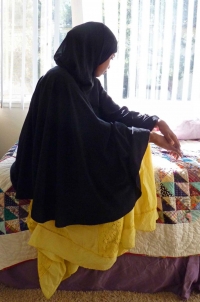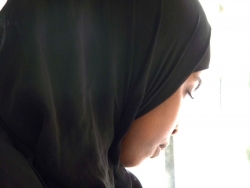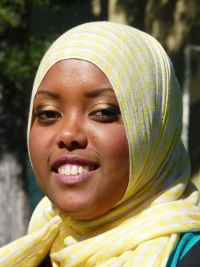 An East County Magazine Special Report
An East County Magazine Special Report
ECM conducted exclusive interviews with people who fled war-torn Somalia and were granted asylum in the U.S. Fearing retribution against family members still in Somalia, the asylees agreed to speak out under condition that their identities be protected. The stories below are real, though the names are pseudonyms. Their tales describe dramatic round-the-world journeys to reach America, hardships endured on the road and inside U.S. detention facilities, as well as hopes for the future as they start new lives through Project Refuge in San Diego.
By Miriam Raftery
February 17, 2011 (San Diego’s East County) – Aisha comes from a rural area near Mogadishu in Somalia. “I couldn’t take it anymore,” she said of the fighting and war-torn conditions that led her to flee her homeland.
She is too traumatized to share details of her treatment in Somalia, a place where women are often raped and brutalized by soldiers, and where young boys are forced at gunpoint into military service. “I had a smuggler take me out of Somalia,” she said, then described her long and difficult journey to freedom.
The smuggler took Aisha first to Dubai in the Middle East, then to Brazil in South America. From there, she traveled through Columbia north to Panama, where she was arrested and spent six months in jail. Finally released, she went through Nicaragua, Honduras, El Salvador, Guatamela, and Mexico. Arriving at the U.S. border, she asked for asylum—a right provided to those fleeing persecution under international law.

Instead of freedom, however, she was taken into custody and confined inside a detention facility in Otay Mesa run by Corrections Corporation of America (CCA), a private prison company that operates the maximum security facility for U.S. Homeland Security.
Aisha, who knew no one in the U.S., spent nine months inside the prison facility while her application for asylum was processed. Her experience is not unusual. Nearly all immigrants who request asylum at U.S. borders are now detained for periods that can range from a few months to years, multiple sources have informed ECM.
Fortunately for Aisha, her application for asylum was granted, and she was freed in October. In January, ECM interviewed her at an apartment in the SDSU college area, where she found transitional housing for three months under Project Refuge, a program created by local Rotary clubs and Somali Family Services to help asylees who have no family or friends locally. (Read ECM's article on Project Refuge.)
“This is my first time ever going to school,” confides Aisha, who spoke no English when she arrives. At first, she walked all the way to a school in the Fairmont area, before learning that she could ride a bus. “I want to learn English and go to school,” she said via a translator, “and then start working at whichever job I can find.”
Cabado's journey began at a refugee camp in Kenya where she faced a heart-breaking decision. “I left my children in November 2009,” said Cabado, a divorced woman whose children are still in the refugee camp. “It’s very hard to bring kids along, very dangerous.”
Taking the risk herself in hopes of someday having a better future for her children, she saved up money to find a smuggler to take her to Djabuti by car, then by plane to Dubai. From there, her journey took her to Russia, Cuba, Columbia, Guatemala, Nicaragua, Mexico, and finally America.
“It was very hard. Coming through some of the places, you got arrested. I was scared. I was robbed,” she said. Once in America, she was surprised to be arrested again—this time, imprisoned for nine months in the CCA facility.
Granted asylum, she came to the Project Refuge apartment. She is grateful to community volunteers and donors who created this safe haven. “I’ll never forget what the community did,” she said, emotion evident in her voice. She shared her future goals. “I want to go to school, start working, and help my three children back home.” Thinking about them is painful for Cabado, who hopes to someday bring them here. But that process can take several years.

Najimo, the only asylee who allowed us to publish her real first name, fled to Kenya to escape the war in Somalia. “My mom was killed,” she said. Najimo wanted to find a better life, but said it was very hard because she lacked documents. Her journey took her to Dubai, Russia, Cuba, several South American countries, and Mexico. “We were in a boat for five days,” she recalled. “I was arrested in Honduras, Nicaragua, and Mexico.”
In America, she spent over 10 months in the CCA detention facility, although she was also granted three months parole during the time her application for asylum was processed. She won asylum in December.
“I am happy that I’m here,” she said, smiling as sunlight from a window frames her face in light. “This is a better place to live than Somalia or Kenya. There is freedom to do what you want to do.”
Though now a young woman, Najimo has never been to school a day in her life. “I want to get educated, and do the same things for other people that have been done to help me,” she said.
Najimo also has another wish. Her grandmother, brothers and sisters all were able to escape Somalia, she learned, but doesn’t know where they are today. “I want to find them,” she said, agreeing to risk having her name published in hopes that it will help her find her relatives. The Red Cross is assisting her in her effort.
Jabir, Yusaf, and Ali are three young men who also came to San Diego from Somalia. Like the women above, all three have been staying in the transitional housing sponsored by Project Refuge. There they can learn skills they will need in America. The three Somali men described their experiences inside the CCA detention facility at Otay, and in some cases, compared that to other detention facilities in which some of them were also confined.
The CCA facility in Otay can spark traumatic memories for detainees who fled war. “There is an ammo (shooting) range out back, so they are hearing gunshots,” said Dory Beatrice, who has worked with Survivors of Torture and helped set up Project Refuge with La Jolla Golden Triangle Rotary Club and seven other Rotary chapters locally. “No one had told them what it was and that they weren’t going to be attacked.”
Yusef spent a year in CCA and was previously detained at a facility in El Centro and another in Lancaster, California. “There they treat us well,” he said of the El Centro facility. “The food is good. They meet the needs of Muslims better than CCA,” he said. But he added, “In El Centro, when you come from Africa, you don’t have services or translation. You are looking for your rights, but there are no attorneys.” Unable to speak English, he recalled, “we cannot tell our story. No lawyers or translation was available to us.”
Worst of all was a Lancaster detention facility where he recalled, “It was in the middle of the mountains and was cold when I came.” There was not enough food, he said. “It was very much like a prison. You cannot take your hands outside a pocket…I get very sick there. I was sick for four months, so I requested to be transferred.” At CCA, he said, he received medical treatment and got well.
After being granted asylum, Yusef said he was released by CCA on the streets of San Diego with only 88 cents in his pocket and no resources provided to him. “I didn’t know anybody…There was a gentleman also released, he was Mexican. He said he would take me to his house…Then I met a Somali guy…he brought me to Somali Family Services.”
Ali spent ten months in detention. Asked what compelled him to flee his homeland, he paused. “It was a very painful process,” he reflected, then said it was too painful to revisit the details.
Jabir said he spent nine months in CCA’s detention facility. “It looks like a jail,” he recalled. Still, in one respect, even that was better than the war-torn homeland that he left behind.
“There was no fighting," the Somali immigrant said of the detention center, "so it was not so bad.”
People who come to the U.S. border asking for asylum to escape persecution have broken no laws and are required to be provided protection under international law, if claims are substantiated. Others ask for asylum after entering the U.S. legally (such as on a tourist visa) or in rare cases, illegally. They may request asylum either through Homeland Security or immigration courts, depending on their circumstances. The odds of being granted asylum are nearly twice as high for those who request asylum via Homeland Security. Overall, around half (51%) of all asylum applications in 2010 were granted, according to the U.S. Department of Justice Executive Office for Immigration Review.
ECM contacted CCA, and U.S. Homeland Security repeatedly to request comment on the treatment of asylees. CCA declined to speak with ECM. We also issued a request for documents under the Freedom of Information Act but received only partial and largely inadequate responses. ECM has repeatedly sought an answer to whether Homeland Security considers dumping people granted asylum on the streets at night with no resources to be an acceptable practice.
Like other asylum-seekers, those at Project Refugees came to America hoping for a better life. "They all want to come here and get legal. That's their goal," said Cheri Attix, an immigration attorney.
Despite hardships, some do attain the American dream of success. A former client of Attix, a Somali who won his asylum case, went to Minnesota where he worked several jobs to put himself through College. He married, worked for the State of Minnesota, and then found work in Nairobi helping implement programs to bring relief supplies to other people in need in his native Somalia.
"He spoke rudimentary English when he came here," his attorney recalls. "Now, he is working for the United Nations.

Sawda Ugas with Somali Family Services, a former refugee herself, translates for one of the women at Project Refuge. "Thank you for doing this," the woman said to benefactors who donated funds and helped her find temporary housing and other services here.
"If they didn't have this, they wouldn't know where to go," Ugas concludes. "This is something that they will never forget for the rest of their lives."







Comments
Legal life as a muslim refugee
I find it odd that this woman would come to a free country like the U.S.A. and still wear the religious dress of an oppressive religion that enslaves women, mutilates their genitalia, subjugates them to second class citizens, would not allow them the right to drive, would not be appalled to have to live with a second or third wife, be required to have her parents "decide" who she will or will not marry, would "under sharia law" say that if 4 men agreed that she was a "whore" because she was nothing more than being in the presence of an unmarried male could be stoned to death. Oh did I mention it is a religion of peace? I do not deny her the desire to have a better life, but to "choose" to come to a country that is truly free and but make a conscience decision to still be oppressed just baffles me.
Danny